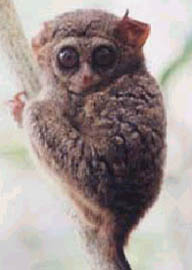The family Tarsiidae contains one genus and five species. Tarsiers are found in the islands of southeastern Asia, including Borneo, Sumatra, some East Indian islands and some Philippine islands.
Tarsiidae
tarsiers
They are species of secondary forest.
Tarsiers are small haplorhine primates, weighing 80-150g. Their fur is silky and buff, grayish brown, or dark brown on the back and grayish or buffy on the underside. They have round heads and remarkably large eyes that are directed forward. Their ears are nearly hairless and seemingly membranous in texture. Their muzzle is short, and they seem to have almost no neck (although they are capable of turning their head over 180 degrees!). Like all haplorhines, tarsiers have hairs on their nose pads. Their forelimbs are short and their hindlimbs elongated. They are unique among mammals in that the elongation of their hindlimbs is the result of lengthening of the tarsals (especially the calcaneum and navicular) rather than the metatarsals. The digits are long and tipped with soft, rounded toe pads. The pollex is not opposable, but the hallux is. All digits have flattened nails except the second and third hind toes, which have claw-like nails used for grooming. The tail is naked except for a few hairs at the tip.
The skulls of tarsiers are unmistakeable due to the huge, forward-directed orbits. These have expanded rims and are separated by a thin interorbital septum. The dental formula is 2/1, 1/1, 3/3, 3/3 = 34. The upper medial incisors are large and pointed; the upper canines are small; and the upper molars are tritubercular.
Tarsiers are species of secondary forest. They are active at night and highly arboreal. During the day, they sleep in dense vegetation, usually on a vertical branch; occasionally, they use a hollow tree. They feed on insects and small vertebrates, which they capture by leaping on their prey and grabbing it with their hands.
Tarsiers are usually found in family groups or by themselves. Family groups are based on a stable pair bond. They are not sexually dimorphic.
The family has no fossil record.
HOME
Primates
Primate FAQ
Tarsier Hotlinks
Tarsier Pictures
Primate Species
Search Primates.com
Primates E-Mail Service
